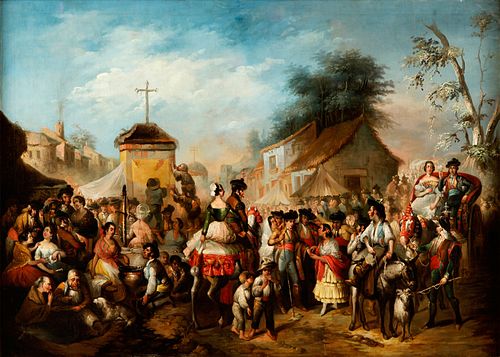MANUEL RODRÃGUEZ DE GUZMÃN (Seville, 1818 - Madrid, 1867). "Pilgrimage". Oil on canvas.
Lot 89
About Seller
Setdart Auction House
Carrer Aragó 346
Barcelona
Spain
Setdart Subastas was born in 2004 and is currently the first online art auction in Spain with solidity, prestige and reliability guaranteed by our more than 60,000 users. Setdart has a young, dynamic and enterprising team ready to successfully manage the purchase and sale of art works through custom...Read more
Estimate:
EUR€30,000 - EUR€40,000
$31,250 - $41,666.67
Absentee vs Live bid
Two ways to bid:
- Leave a max absentee bid and the platform will bid on your behalf up to your maximum bid during the live auction.
- Bid live during the auction and your bids will be submitted real-time to the auctioneer.
Bid Increments
| Price | Bid Increment |
|---|---|
| EUR€0 | EUR€10 |
| EUR€200 | EUR€25 |
| EUR€500 | EUR€50 |
| EUR€1,000 | EUR€100 |
| EUR€3,000 | EUR€200 |
| EUR€5,000 | EUR€500 |
| EUR€10,000 | EUR€1,000 |
| EUR€20,000 | EUR€2,000 |
| EUR€50,000 | EUR€5,000 |
About Auction
By Setdart Auction House
Nov 10, 2021
Set Reminder
2021-11-10 08:00:00
2021-11-10 08:00:00
America/New_York
Bidsquare
Bidsquare : 19th & 20th Century paintings and Decorative Arts
https://www.bidsquare.com/auctions/setdart-auction-house/19th-20th-century-paintings-and-decorative-arts-7800
Setdart Auction House sofia@setdart.com
Setdart Auction House sofia@setdart.com
- Lot Description
MANUEL RODRÃGUEZ DE GUZMÃN (Seville, 1818 - Madrid, 1867). "Pilgrimage". Oil on canvas. Certificate of authenticity, issued by Enrique Valdivieso, professor of Art History at the University of Seville, is attached. Measurements: 101 x 141 cm; 116 x 156 cm (frame). In his certificate, Enrique Valdivieso indicates that this work clearly belongs to the Sevillian school of the mid-19th century, and that in it it is possible to clearly recognize the characteristic expressive configuration of the physical types typical of the style of Manuel RodrÃguez de Guzmán, of which it is an authentic work. Due to its technical characteristics, Valdivieso dates this work around 1850, shortly before the painter's move to Madrid in 1852. An outstanding painter specializing in Andalusian folkloric and genre scenes, RodrÃguez de Guzmán began his training at the Academy of Fine Arts of Santa Isabel de HungrÃa in Seville. There he was a disciple of José DomÃnguez Bécquer, who initiated him in costumbrista painting, and under whose direction the painter developed his first stage. He progressively began to undertake paintings of greater compositional commitment, set in larger scenes than those of his first works. Attracted by Isabel II's interest in his paintings, in 1854 he settled in Madrid with the intention of working as a court painter. This interest crystallized in a proposal that RodrÃguez de Guzmán submitted to the queen, consisting in the creation of a wide pictorial series that included the different festivals, fairs and pilgrimages that were celebrated in Spain, committing himself to produce one painting of this type per year. Although he was finally unable to complete the project, the painter carried out several works that became part of the royal collection, such as his masterpiece, "La feria de Santiponce". A friend of Antonio MarÃa Esquivel, he participated assiduously in the National Exhibitions of Fine Arts, obtaining in 1858 an honorable mention for his work "Rinconete y Cortadillo", inspired by Cervantes' "Exemplary Novels". The activity of RodrÃguez de Guzmán in Madrid enjoyed special official predilection, since the State acquired from him in 1864 two works, today in unknown whereabouts, entitled "Las habaneras" and "Gitana diciendo la buenaventura a unos gallegos". He also worked on bullfighting themes, history and even portraits, revealing in the latter a workmanship marked by a technical casualness of Goyaesque evocation, perhaps derived from a deep friendship with the painter Eugenio Lucas. His painting was characterized by a brilliant coloring, as well as by his great facility to capture with naturalism and instantaneity the popular types, organized in scenes full of minutely described figures. His art also stands out for its compositional mastery, as well as for the use of an agile and undone brushstroke, which gives great vitality to his scenes.
- Shipping Info
-
In-house shipping available. Please inquire at admin@setdart.com.
-
- Buyer's Premium



 EUR
EUR CAD
CAD AUD
AUD GBP
GBP MXN
MXN HKD
HKD CNY
CNY MYR
MYR SEK
SEK SGD
SGD CHF
CHF THB
THB
















